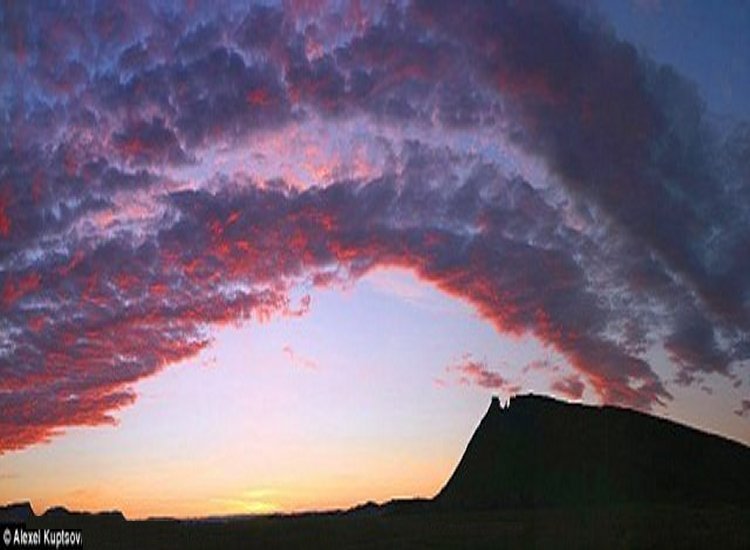A. Sutherland - AncientPages.com - Many people believe that one of the oldest astronomical observatories is Stonehenge. However, an ancient and spectacular Sunduki (or "home of the gods") could today be considered the world's oldest astronomical observatory.
It was not only a place of huge religious significance in the ancient world of our ancestors but also its stargazing capital.
Sunduki is referred to as the Siberian Stonehenge and is believed to be at least 16,000 years old, thus it's much older than Stonehenge.

Starscape: Sunduki is a series of eight box-shaped sandstone outcrops on a remote flood plain on the bank of the Bely Iyus river in remote Siberia.
The mountain ridge Sunduki (the Boxes) was long studied by Professor Vitaly Larichev, of the Institute of Archaeology and Ethnography at the Siberian Branch of the Russian Academy of Sciences. According to Larichev, Sunduki is the oldest astronomical observatory certainly in Asia. Its age is about 16,000 years old. The ancient inhabitants of this valley daily observed the sunset, the sunrise, and the moon.
His studies showed that the ancient Siberians were able to use a combination of giant rocks and chinks in the stony landscape to make their astronomical observations, including identifying a point where the sun rises on the summer solstice.
According to Professor Vitaly Larichev, the ancient Siberian astronomers could also tell time and direction easily. Referring to a certain petroglyph depicting a dragon pointing in one direction, and snake in the other, he explained:
“If the sun were shining, we could tell the time. In the morning the shadow moves along the snake’s body from his head to his tail, and in the afternoon it comes from the other direction along with the dragon. From the same observation point, you can determine true north and south by sighting along the mountains.”
High on one cliff wall is a rock engraving showing dragon heads in one direction, and snakeheads in the other.
The rich region of the region of Sunduki delivered many fascinating finds like burial mounds (kurgans), rock drawings, and stone monuments.
The word 'Sunduk' in Russian means 'chest' or 'trunk' which explains how the place got its modern name.
"For many years I tried to unravel these mystery 'chests'," said Professor Vitaly Larichev said. Determined to decode some of the mysteries of Sunduki, he admits he became an 'astro-archeologist'.
"We don't dig in the ground - we study what ancient people knew about astronomy', he said.
What I discovered was a surprise even to myself. Comparing maps accumulated over many years of astronomical observations, I came to understand that here in Sunduki, we can see the oldest astronomical observatory certainly in Asia. Its age is about 16,000 years old. The ancient inhabitants of this valley daily observed the sunset, the sunrise and the moon'. They did so for many thousands of years since then, which means it's millennia-old tradition. Based on what is known so far, the first sundials existed about 3,500 years ago in Egypt. Ancient Siberian astronomers did not have such instruments.
Instead, they used giant rocks and chinks in the stone architecture in this Siberian landscape for their calculations and observations.
Professor Larichev informed that he found 'numerous ancient solar and lunar observatories around Sunduki.
"This square pattern of stones on the ground shows you the place. I knew there would be an orientation point, but we had to search through the grass for a long time to find it. Now, look up to the top of that ridge. You see a place where there is a crack between the rocks? If you were here on the summer solstice, you would see the sunrise right there. Or you would if you were here 2,000 years so. Now the timing is slightly different," Professor Larichev explained.
High on one cliff wall is a rock engraving showing dragon heads in one direction, and snakeheads in the other.
"If the sun were shining, we could tell the time,' Professor Larichev said. "In the morning the shadow moves along the snake's body from his head to his tail, and in the afternoon it comes from the other direction along the dragon. From the same observation point you can determine true north and south by sighting along the mountains."There is a gallery of rock art. Some dates back several centuries BC and so is relatively modern.
But a mysterious white horse found not far from the first 'chest' on Black Mountain was carved in the rock and is well preserved - yet scientists suggest that this petroglyph appeared 16,000 years ago, during the Ice Age, establishing this as a site of human activity over many millennia.
"It was 'the home of gods, great artists, and skywatchers', said the professor. It was more than this, too."
There are also burial mounds and other manmade constructions - including irrigation channels - which have yet to be fully investigated. The great story of Sunduki is only partly known and many ancient secrets of Sunduki have not been revealed.
Written by – A. Sutherland - AncientPages.com Senior Staff Writer
Copyright © AncientPages.com All rights reserved. This material may not be published, broadcast, rewritten or redistributed in whole or part without the express written permission of AncientPages.com
Expand for referencesReferences:
Kira Van Deusen, Singing Story, Healing Drum: Shamans and Storytellers of Turkic Siberia






